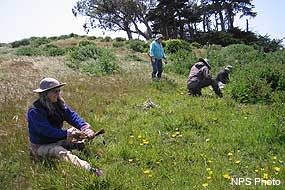California Invasive Weed Awareness WeekInvasive plants are one of the greatest threats to the integrity of native habitats and ecosystems. Invasive weeds are known to heavily colonize habitats with an adverse effect on their adapted environment. In northern California, invasive weeds reduce plant and animal diversity, restrict dune movement, and may create a fire hazard. Invasive Weed Awareness Weeks were established to educate the public about invasive weeds and to encourage citizens to help preserve their National Parks and public lands by removing invasive weeds. California Invasive Weeds Awareness Week (CIWAW) is an annual event that brings attention to the problems caused by invasive plants in California, and to the work of local groups that work to protect our natural areas and rangelands. In 2004, the California state legislature signed a proclamation declaring California Invasive Weeds Awareness Week to begin the third Monday of July each year. The last year in which the North American Weed Management Association coordinated an Annual National Invasive Weeds Awareness Week (NIWAW) appears to have been in 2009 and their website does not indicate that any future NIWAWs are scheduled. NIWAWs were organized from 2000 through 2009 to bring people and groups from across the country together to focus national attention on the severe impacts caused by invasive weeds. 
Volunteer Opportunities:While Point Reyes National Seashore has not hosted any volunteer workdays for California Invasive Weeds Awareness Week since 2010, Point Reyes National Seashore invites the public to participate in regular Habitat Restoration Program workdays. If you can't make it out to volunteer but would still like to get involved, see how you can make a difference from your own home at the California Invasive Plant Council's Responsible Landscaping and Don't Plant a Pest! Bay Area web pages. Visit the San Francisco Bay Area Inventory & Monitoring Network's Invasive Plants Early Detection page to learn more and to download Plant ID Cards featuring some of the high-priority invasive species. If you see any of these plants in the park, take a photo of it and note where you found the plant, and then LET US KNOW! Contact Ellen Hamingson at 415-464-5196 or by email. To learn more about invasive plants, visit the California Invasive Plant Council website. Past Volunteer OpportunitiesBelow are some brief descriptions of the opportunities that were planned for past Invasive Weed Awareness Weeks. If you, as an individual or as a group, would like more information or wish to participate in any future Invasive Weeds Awareness Weeks at Point Reyes, please contact Ellen Hamingson at 415-464-5196 or by email. CIWAW 2010 CIWAW 2009 CIWAW 2008 NIWAW 9 |
Last updated: March 15, 2025
